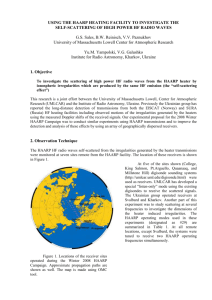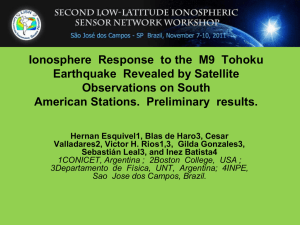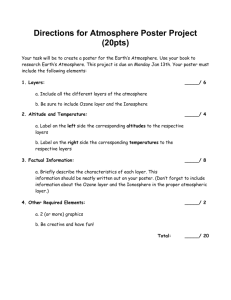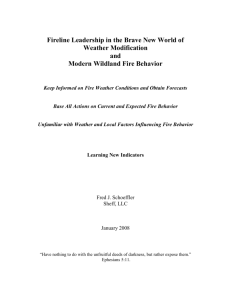Written by: Malie Collins Written on: February 25, 2013 Assignment
advertisement
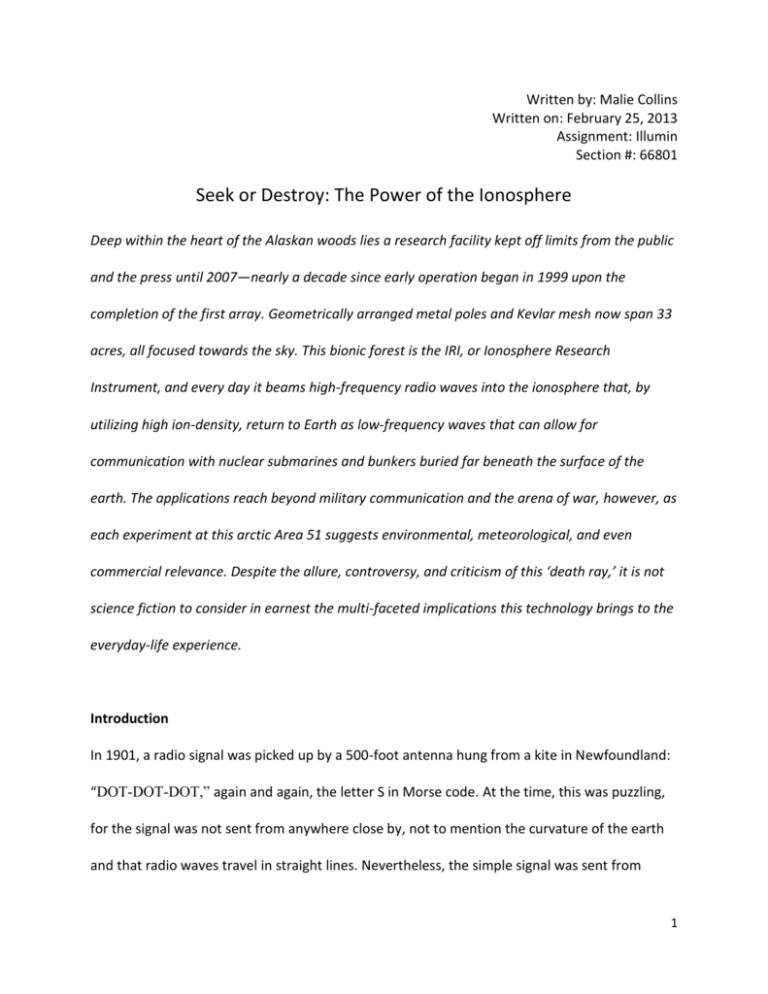
Written by: Malie Collins Written on: February 25, 2013 Assignment: Illumin Section #: 66801 Seek or Destroy: The Power of the Ionosphere Deep within the heart of the Alaskan woods lies a research facility kept off limits from the public and the press until 2007—nearly a decade since early operation began in 1999 upon the completion of the first array. Geometrically arranged metal poles and Kevlar mesh now span 33 acres, all focused towards the sky. This bionic forest is the IRI, or Ionosphere Research Instrument, and every day it beams high-frequency radio waves into the ionosphere that, by utilizing high ion-density, return to Earth as low-frequency waves that can allow for communication with nuclear submarines and bunkers buried far beneath the surface of the earth. The applications reach beyond military communication and the arena of war, however, as each experiment at this arctic Area 51 suggests environmental, meteorological, and even commercial relevance. Despite the allure, controversy, and criticism of this ‘death ray,’ it is not science fiction to consider in earnest the multi-faceted implications this technology brings to the everyday-life experience. Introduction In 1901, a radio signal was picked up by a 500-foot antenna hung from a kite in Newfoundland: “DOT-DOT-DOT,” again and again, the letter S in Morse code. At the time, this was puzzling, for the signal was not sent from anywhere close by, not to mention the curvature of the earth and that radio waves travel in straight lines. Nevertheless, the simple signal was sent from 1 Cornwall, England, and had somehow crossed the expanse of the Atlantic Ocean [1]. What was not understood was that an electromagnetically charged atmospheric layer, the ionosphere, was responsible for reflecting the signal back down to the ground. Now, the radio exists in our cars, satellite navigation, and in the remote detonator of an evil Bond villain. It is understood that at any moment, Earth is pelted with 170 billion megawatts of radiation the likes of x-ray and ultraviolet. These collide with atoms in the air, such as nitrogen and oxygen, in a process that strips away electrons, leaving behind free-drifting, positively charged ions. At high altitudes, each ion is far enough from the other that it can take extensive periods of time for an ion to chance upon a free electron and successfully bind. Thus, these swirling bands of charged particles do not readily dissipate and can stretch from 50 to 500 miles into the gap of sky between the highest weather balloons and lowest satellites [1]. This region is the target for the Ionosphere Research Instrument (IRI), the device at the core of upper atmospheric studies, solar-terrestrial physics, and radio science in the High frequency Active Auroral Research Program (HAARP) [2]. Though HAARP is operated by the United States Air Force and Navy, the Defense Advanced Research Projects Agency (DARPA), and BAE Advanced Technologies (once owned by petroleum conglomerate, Arco), the military applications do not overshadow numerous current and potential impacts on civilian life [2]. This narrative is not uncommon for computers, the Internet, and even the EpiPen, first designed to protect soldiers from nerve agents in chemical warfare, all share a military origin and a consumer-oriented outcome [3]. 2 Engineering the IRI “At any time over Fairbanks, there is more energy than there is in the entire United States.” – Former Alaskan Senator Ted Stevens [1] The HAARP program seeks to harness the low-frequency energy at its site near Gakona, Alaska by predominantly using the high-frequency (HF) and high power phased array radio transmitter to stimulate small, well-defined volumes of the ionosphere. The resulting effects are observed via both onsite and offsite modern geophysical instruments including Extremely Low Frequency (ELF) and Very Low Frequency (VLF) receivers that interpret the returning radio waves. Additionally, magnetometers measure the earth’s magnetic field and its variations, and riometers (relative ionosphere opacity meters) sense ionosphere absorption as layers of the ionosphere fluctuate and can disappear entirely at different times of the day [2]. The IRI is the most essential instrument in this symphony of equipment, and has impressive capabilities. Breaking down the phrase ‘high-frequency and high power phased array radio transmitter’ reveals the functionality of the IRI. It is designed to transmit a narrow beam of high-power, meaning high-frequency, radio signals in the range of 2.8 to 10 megahertz (MHz) in frequency. The antenna sits on a gravel pad and consists of 180, 72-foot-tall metal towers mounted on thermopiles 80 feet apart in a 12 x 15 grid (see Fig. 1). The purpose of the poles is to support two pairs of crossed dipole antennas, or one low band (emitting a frequency of 2.8 to 8.3 MHz) and one high band (responsible for the range of 7 to 10 MHz). The system is surrounded by a 3 fence to prevent any damage to the antenna or to wild animals, and an elevated screen mounted 15 feet above the ground reflects any remnant energy upwards while also allowing vehicles to access 30 environmentally-controlled shelters. These shelters contain the highpower equipment to be paired with the high-frequency in the array, with six pairs of 10 kilowatt (kW) transmitters, totaling at an overall radiated power of 3.6 megawatts [4]. The transmitters, Figure 1: The IRI array up-close, with tall, interconnected metal poles and the associated shelters containing the high-power equipment needed to project 3.6 mW at the ionosphere above the antenna. The antenna includes all of these poles as a whole. [Source: HAARP Photo Gallery] in turn, utilize electricity produced by an onsite power plant housing five 3,600-horsepower diesel-electric generators—each as powerful as a locomotive [1]. It appears as though 4 politicians such as Sen. Ted Stevens, who sought federal funding for HAARP, were not stretching too far beyond the truth after all. The precision of the IRI array is uncanny; each of the 180 antennas can be adjusted via computer, and it is in this manner that the full array forms a narrow antenna pattern directed at the ionosphere [2]. Such fine-tuned calibration allows the IRI to fire a beam as narrow as 5 degrees as wide as 60 degrees of sky [1]. This translates into a volume of several tens of miles in diameter down to a region a few hundred meters thick located directly above HAARP. The transmitted signal diverges as it moves upward through the atmosphere and undergoes partial absorption at an altitude depending on which frequency was transmitted. What is left of the transmission either reflects back to Earth or continues through the ionosphere and into space, continuing to spread apart as it travels (see Fig. 2). Consequently, by the time the signal reaches the ionosphere, its intensity is less than 3 microwatts—0.000003 watts—per square centimeter. The sun’s electromagnetic radiation, comparatively, is thousands of times stronger reaching the earth, and the sun’s ultraviolet energy which creates the ionosphere is still hundreds of times stronger than the arriving transmission [2]. Thus, any reflected energy is extremely lowfrequency, and it is these radio waves that can penetrate the earth’s crust or travel deep beneath the ocean waves. 5 Figure 2: A model demonstrating the injection of waves into the atmosphere by the HAARP facility. The diverging of the signal is shown by each of the dashed lines in the series spreading outward from the earth’s surface. At each level of the atmosphere, some waves are reflected back, while some are reflected to the conjugation point. [Source: Geophysical Research Letters] HAARP’s Mission and Our Future The application of such powerful low-frequency radio waves begins with the military, as the survival of the now $30 million-plus research project has relied upon the perpetual interest of the Air Force and Navy [1]. However, an energized ionosphere is a double-edged sword—each military use is paired with an equally formidable consumer implementation (see Fig. 3 for main areas of application). 6 Figure 3: The various applications of the IRI display and HAARP research, with corresponding altitude and general location of subject. [Source: Wired] From a holistic perspective, HAARP is in continuous research mode. Not only does HAARP house equipment capable of observing every electro-physical anomaly of the naturally occurring aurora borealis, but it can create artificial optical emissions of its own at specific wavelengths. It has been concluded that the direction in which the high-frequency beam is pointed affects the production of artificial airglow, as the emissions greatly increase when the beam is pointed along a geomagnetic field line (where the magnetic field is horizontal along latitudinal lines) [4]. The most intense electromagnetic emission closest to earth, known as the ELF/VLF chorus, drives electron precipitation and creates these pulsating auroras [5]. The full impact of these 7 artificial lights in the sky is unknown, but varying the trajectory of the beam, the location in the earth’s magnetic field, and the frequency of the beam itself allows for further investigation of the effect of solar wind on electrons in the chorus, which affect both satellite performance and Space Weather [5]. Satellites in particular are of extreme importance due to nations’ dependence on satellites for every avenue of communication ranging from intelligence communities to human communities. Therefore, communication—and its sister, surveillance— are paramount. Militarily speaking, the thought of being able to penetrate thousands of feet of water to reach a submarine caught the attention of the Navy, which had previously built an array in the Midwest to transmit a signal through bedrock. Its construction had carved a hundred-foot-wide, 84-mile-long streak in a natural landscape that included a national forest. Thus, the skyward technology of HAARP, and similar facilities in Puerto Rico and Siple Station, Antarctica, is the new, environmentally friendly alternative—and a far more widely applicable option [5]. Having detected a bunker 300 feet below ground, HAARP research is proving itself worthy, and considerations are being made as to whether an array such as Alaska’s IRI could be placed on the deck of an aircraft carrier to increase its portability and range. In fact, modulated heating of the lower ionosphere using the HAARP HF heater has successfully been used to transmit signals from the mainland to a vessel out at sea, even amidst the background noise, or hum, of the ship [6]. Had such technology been available at the height of the Iraq war, the hunt for terrorist cells 8 may have been expedited. In wars to come, the lives of service members and the nation’s tax dollars may be saved. Unsurprisingly, satellites may be saved as well. Protecting satellites from nuclear bombs set off in orbit by a rogue state is part of the most recent phase of funding for HAARP, as this new frontier of technological combat is a concern of the Department of Defense, with real-world significance. Such an attack and the following electromagnetic pulse would paralyze a technologically interwoven society such as the United States. Reminiscent of scenes from the film Live Free or Die Hard, the country would be shut down with satellites destroyed by the atmospheric blast and electronic devices destroyed by the high acceleration of electric and magnetic components within the electromagnetic pulse. The pulse can induce voltage changes anywhere from 100 to 10,000 volts in circuits and radio electronic equipment, much like what would happen to household appliances in a power-surge [7]. Using the IRI technology, however, ultralow-frequency waves in the ionosphere can theoretically push particles out of their natural spin, redirecting them back into the lower atmosphere where they would be safely reabsorbed. Similarly, naturally-occurring storms such as Hurricane Katrina, which are triggered and perpetuated by latent hot/energized and cold air, can be pushed off track and diverted [1]. This is the subject matter of the latest research efforts out of Gakona, Alaska, as well as for the repurposing of oil-rich deposits. One particular application of the array stems from the origin of the array itself: dependency on fossil fuels. Part of the selection of Gakona, Alaska as the location for HAARP is tied to Alaskan oil, some of which was nearly impossible to transport for exportation. HAARP is able to use that 9 oil to power the massive ionospheric heater that is IRI, and in turn the high-energy in the ionosphere waiting to be maximized may one day power our largest cities [4]. Finally, one of the simplest means of human contact is directly influenced by the ionosphere every day: the radio. The ionized medium of the ionosphere does not only regulate the performance of satellite-to-ground communication as the medium through which signals travel, but is also crucial to radio. For instance, AM broadcasts are typically heard during the daytime within a few tens of miles from the transmitting station. At night, however, these programs can sometimes be heard hundreds of miles away due to the shift of ion density in the ionosphere. Poor daytime reflection can change to good nighttime reflection. Furthermore, long-range HF communication that utilizes multiple hops, or reflections between the ground and the ionosphere, often suffer from amplitude fading due to interference between signals [4]. Additionally, the sun’s radiation forms and regulates the ionosphere, and therefore sudden variation in the radiation from solar flares and even lightning will affect radio performance. HAARP technology is able to control the ionosphere in a very controlled manner, and thus improvements and expansions to our widespread radio usage are more than tangible. Conclusion A military complex hidden away in the middle of no-man’s land calls to mind the film Independence Day, and a technology born of intellectual curiosity with the power to defend, seek, and destroy harkens to Tony Stark’s Iron Man. However, the Ionosphere Research Instrument at HAARP currently holds relevance in our daily lives and holds greater promise for 10 future applications ranging from improved environmental stability to expedited data and communication modes. The devices we plug into each day and the very fabric of our lives is in one way or another supported by that space in the sky. It is not fiction, but fact, and the power lies in the ionosphere. References [1] N. Shachtman, "Sky Lab," Wired, vol. 17, no. 08, pp. 70–78, Aug. 2009. [2] "HAARP Fact Sheet," The High Frequency Active Auroral Research Program, Jan. 24, 2012. [Online]. Available: http://www.haarp.alaska.edu/haarp/factSheet.html. [Accessed Feb. 17, 2013]. [3] A. Lex, "Military Inventions That We Now Use Every Day," Business Insider, Nov. 24, 2012. [Online]. Available: http://www.businessinsider.com. [Accessed Feb. 19, 2013]. [4] E.J. Kennedy, P. Rodriguez & C.A. Selcher, "The High Frequency Active Auroral Research Program," Naval Research Laboratory, Nov. 24, 2012. [Online]. Available: http://www.nrl.navy.mil/research/nrl-review/2004/atmospheric-science-and technology/kennedy/. [Accessed Feb. 19, 2013]. [5] U.S. Inan & T.F. Bell, "Polar Aeronomy and Radio Science (PARS) ULF/ELF/VLF Project," Star Laboratory, Stanford University, July 2001. [6] U.S. Inan, M.F. Golkowski & D.L. Carpenter, "Multi-hop whistler-mode ELF//VLF signals and triggered emissions excited by the HAARP HF heater, "Geophysical Research Lett., vol. 31, no. L24805, pp. 1–4, Dec. 28, 2004. 11 [7] Y. Zaitsev, "From radio telescopes to electromagnetic weapons," Rianovosti, pp. 1–2, Nov. 5, 2007. [Online]. Available: http://en.rian.ru/analysis/20070511/65348455.html. [Accessed Feb. 20, 2013]. [8] HAARP Photo Gallery. [Online]. Available: http://www.haarp.alaska.edu/haarp/photos.html 12
